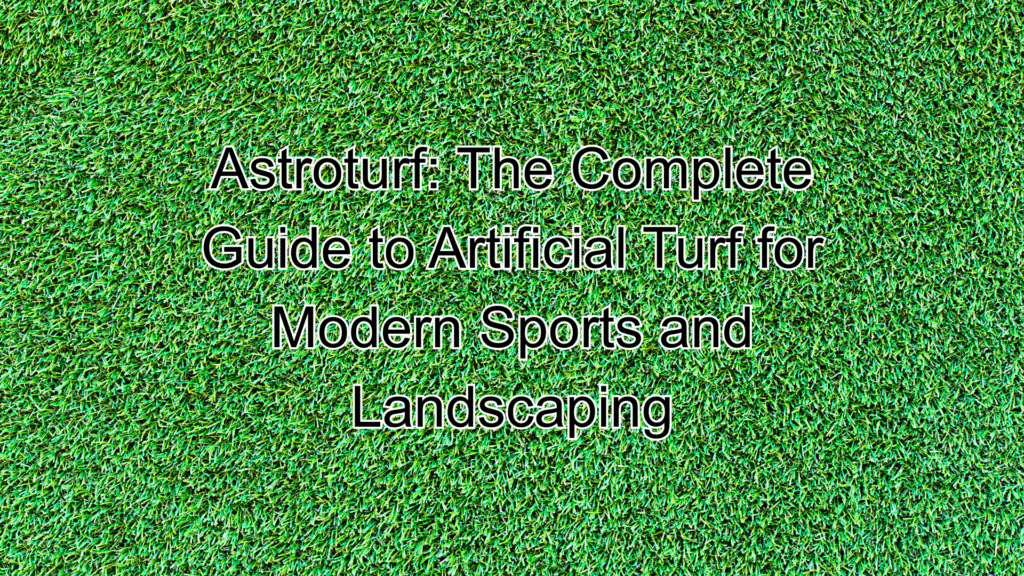- 1. Introduction to Astroturf
- 2. What Is Astroturf?
- 3. Evolution of Artificial Turf
- 4. Benefits of Astroturf Over Natural Grass
- 5. Types of Astroturf and Artificial Turf
- 6. Applications of Astroturf in Sports and Landscaping
- 7. How Is Astroturf Installed?
- 8. Maintenance Tips for Artificial Turf
- 9. Cost and Longevity of Astroturf
- 10. Eco-Friendly Features of Artificial Turf
- 11. Conclusion
1. Introduction to Astroturf
For decades, athletes, homeowners, and landscapers have searched for reliable, low-maintenance alternatives to natural grass. One of the most recognized names in this industry is astroturf. While the term is often used to describe all forms of artificial turf, astroturf refers to the pioneering brand that introduced synthetic grass solutions to sports fields and beyond. Today, both astroturf and artificial turf are widely used for sports complexes, gardens, playgrounds, and commercial projects.
2. What Is Astroturf?
Astroturf is a brand of artificial turf developed in the 1960s, originally created as a synthetic alternative to natural grass for indoor stadiums. Over time, the technology has evolved, and astroturf now represents high-quality synthetic grass solutions used worldwide. Unlike natural lawns, which require constant watering, mowing, and fertilizing, astroturf delivers a lush, green appearance with minimal upkeep.
3. Evolution of Artificial Turf
The journey of artificial turf began with the introduction of astroturf in the Houston Astrodome in 1966. Early versions were short-pile and lacked cushioning, but modern artificial turf has significantly improved. Today’s turf features advanced fibers, shock-absorbing layers, and realistic textures, making it almost indistinguishable from natural grass.
4. Benefits of Astroturf Over Natural Grass
Switching to astroturf offers numerous benefits:
- Low Maintenance: No need for mowing, watering, or fertilizing.
- Durability: Withstands heavy foot traffic and intense play.
- All-Weather Use: Usable in all climates without muddy patches.
- Cost Efficiency: Reduces long-term maintenance expenses.
- Safety Features: Modern turf includes shock pads for injury reduction.
- Consistent Appearance: Always green and lush, regardless of weather.
5. Types of Astroturf and Artificial Turf
There are various types of artificial turf designed for different purposes:
- Sports Turf: Designed for football, cricket, rugby, and hockey fields.
- Multisport Turf: A versatile surface suitable for multiple sports activities.
- Landscape Turf: Used in gardens, balconies, rooftops, and commercial spaces.
- Playground Turf: Safe and cushioned for children’s play areas.
- Pet Turf: Specially designed for pet-friendly spaces, with easy cleaning features.
6. Applications of Astroturf in Sports and Landscaping
Astroturf and artificial turf are used in a wide range of applications:
- Stadiums and Arenas: Popular in professional football, baseball, and rugby.
- Schools and Colleges: Multipurpose fields and playgrounds.
- Residential Gardens: Homeowners use turf for lawns and rooftops.
- Commercial Landscaping: Offices, hotels, and shopping malls prefer turf for aesthetics.
- Events and Exhibitions: Temporary flooring for events and shows.
7. How Is Astroturf Installed?
Installing astroturf involves several steps:
- Surface Preparation: Remove existing grass and level the ground.
- Base Layer: Add a foundation of crushed stones or sand for stability.
- Drainage System: Prevents waterlogging and ensures longevity.
- Rolling Out Turf: Spread the astroturf evenly across the prepared base.
- Joining Seams: Use adhesive or seaming tape for neat finishes.
- Infill Application: Add sand or rubber granules for cushioning.
- Final Brushing: Lifts fibers to create a natural grass-like appearance.
8. Maintenance Tips for Artificial Turf
Although artificial turf requires less care than natural grass, regular maintenance keeps it in top condition:
- Regular Brushing: Prevents turf fibers from flattening.
- Cleaning: Remove leaves, dust, and debris.
- Water Rinse: Wash the turf to remove dirt and spills.
Infill Check: Maintain proper levels of sand or rubber granules. - Edge Inspection: Ensure turf remains secure and free from damage.
9. Cost and Longevity of Astroturf
The cost of installing astroturf varies depending on quality, pile height, and intended use. While initial installation is more expensive than natural grass, the long-term savings make it a cost-effective choice. High-quality artificial turf can last 10–15 years with proper care, making it a smart investment for both residential and commercial projects.
10. Eco-Friendly Features of Artificial Turf
Modern astroturf and artificial turf options incorporate eco-friendly features:
- Conserves water by eliminating irrigation needs.
- Reduces use of harmful pesticides and fertilizers.
- Many products are made from recycled or recyclable materials.
- Minimizes carbon emissions from lawn maintenance equipment.
This makes artificial turf an environmentally responsible solution for sustainable landscaping.
11. Conclusion
Astroturf remains a pioneer in synthetic grass solutions, while artificial turf as a whole has revolutionized landscaping and sports flooring. With benefits like durability, low maintenance, eco-friendliness, and year-round greenery, astroturf is a versatile choice for homeowners, businesses, and sports facilities alike. Whether for a stadium, school playground, or residential garden, astroturf offers a long-lasting and cost-effective flooring solution.
FAQs About Astroturf
